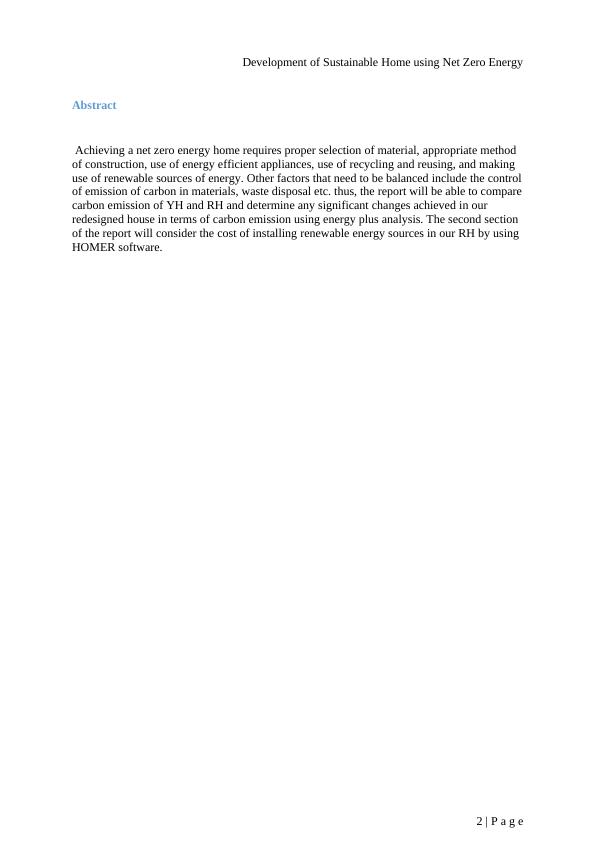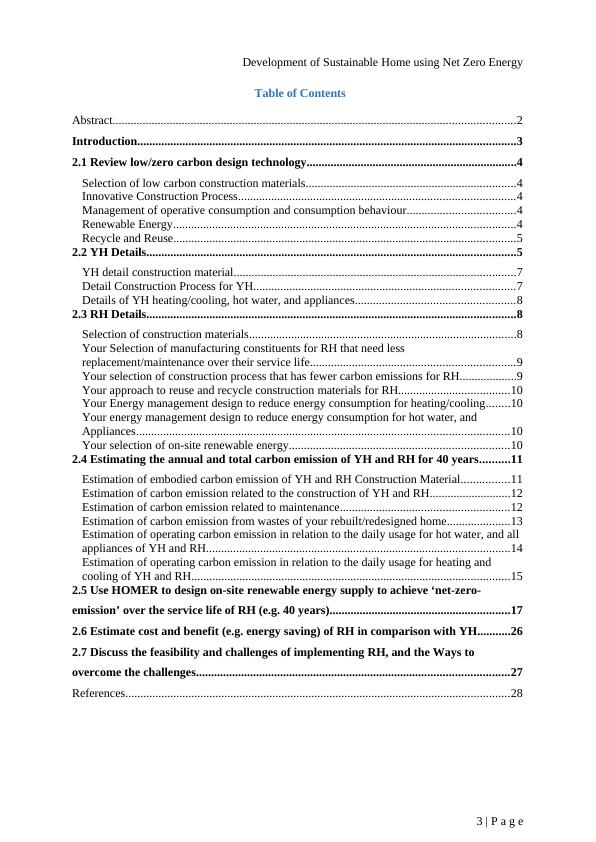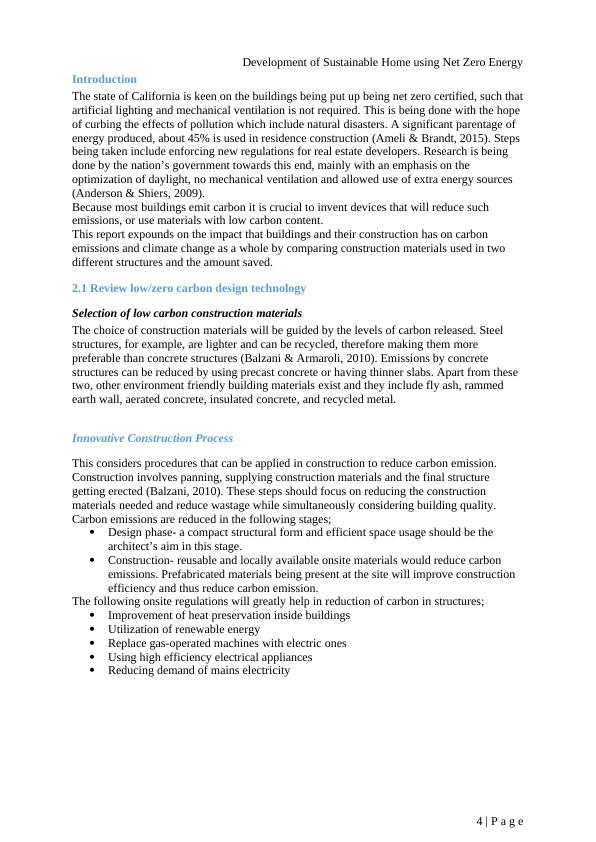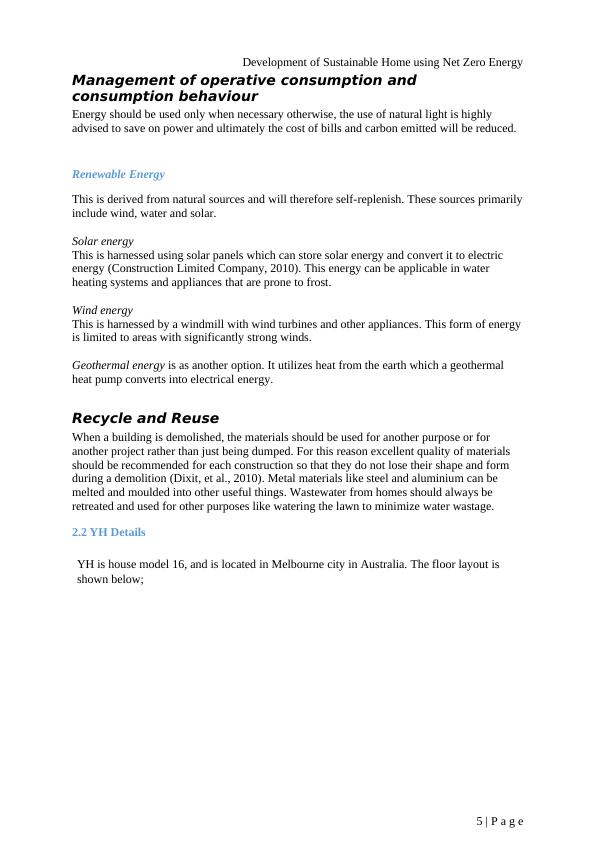Development of Sustainable Home using Net Zero Energy
Build a sustainable home with net zero energy and compare it with your current home on energy and emissions aspects.
28 Pages2719 Words339 Views
Added on 2023-03-30
About This Document
This report explores the development of a sustainable home using net zero energy. It discusses the selection of low carbon construction materials, innovative construction processes, management of energy consumption, and the use of renewable energy sources. The report also estimates the carbon emissions of a traditional home and a redesigned net zero energy home, and discusses the feasibility and challenges of implementing sustainable homes.
Development of Sustainable Home using Net Zero Energy
Build a sustainable home with net zero energy and compare it with your current home on energy and emissions aspects.
Added on 2023-03-30
ShareRelated Documents
Development of Sustainable Home using Net Zero Energy
DEVELOPMENT OF SUSTAINABLE HOME USING NET ZERO ENERGY
By (Name)
Course
Professor’s name
University name
City, State
Date of submission
1 | P a g e
DEVELOPMENT OF SUSTAINABLE HOME USING NET ZERO ENERGY
By (Name)
Course
Professor’s name
University name
City, State
Date of submission
1 | P a g e

Development of Sustainable Home using Net Zero Energy
Abstract
Achieving a net zero energy home requires proper selection of material, appropriate method
of construction, use of energy efficient appliances, use of recycling and reusing, and making
use of renewable sources of energy. Other factors that need to be balanced include the control
of emission of carbon in materials, waste disposal etc. thus, the report will be able to compare
carbon emission of YH and RH and determine any significant changes achieved in our
redesigned house in terms of carbon emission using energy plus analysis. The second section
of the report will consider the cost of installing renewable energy sources in our RH by using
HOMER software.
2 | P a g e
Abstract
Achieving a net zero energy home requires proper selection of material, appropriate method
of construction, use of energy efficient appliances, use of recycling and reusing, and making
use of renewable sources of energy. Other factors that need to be balanced include the control
of emission of carbon in materials, waste disposal etc. thus, the report will be able to compare
carbon emission of YH and RH and determine any significant changes achieved in our
redesigned house in terms of carbon emission using energy plus analysis. The second section
of the report will consider the cost of installing renewable energy sources in our RH by using
HOMER software.
2 | P a g e

Development of Sustainable Home using Net Zero Energy
Table of Contents
Abstract......................................................................................................................................2
Introduction..............................................................................................................................3
2.1 Review low/zero carbon design technology......................................................................4
Selection of low carbon construction materials......................................................................4
Innovative Construction Process............................................................................................4
Management of operative consumption and consumption behaviour....................................4
Renewable Energy..................................................................................................................4
Recycle and Reuse..................................................................................................................5
2.2 YH Details...........................................................................................................................5
YH detail construction material..............................................................................................7
Detail Construction Process for YH.......................................................................................7
Details of YH heating/cooling, hot water, and appliances.....................................................8
2.3 RH Details...........................................................................................................................8
Selection of construction materials.........................................................................................8
Your Selection of manufacturing constituents for RH that need less
replacement/maintenance over their service life....................................................................9
Your selection of construction process that has fewer carbon emissions for RH...................9
Your approach to reuse and recycle construction materials for RH.....................................10
Your Energy management design to reduce energy consumption for heating/cooling........10
Your energy management design to reduce energy consumption for hot water, and
Appliances............................................................................................................................10
Your selection of on-site renewable energy.........................................................................10
2.4 Estimating the annual and total carbon emission of YH and RH for 40 years..........11
Estimation of embodied carbon emission of YH and RH Construction Material................11
Estimation of carbon emission related to the construction of YH and RH...........................12
Estimation of carbon emission related to maintenance........................................................12
Estimation of carbon emission from wastes of your rebuilt/redesigned home.....................13
Estimation of operating carbon emission in relation to the daily usage for hot water, and all
appliances of YH and RH.....................................................................................................14
Estimation of operating carbon emission in relation to the daily usage for heating and
cooling of YH and RH..........................................................................................................15
2.5 Use HOMER to design on-site renewable energy supply to achieve ‘net-zero-
emission’ over the service life of RH (e.g. 40 years)............................................................17
2.6 Estimate cost and benefit (e.g. energy saving) of RH in comparison with YH...........26
2.7 Discuss the feasibility and challenges of implementing RH, and the Ways to
overcome the challenges........................................................................................................27
References................................................................................................................................28
3 | P a g e
Table of Contents
Abstract......................................................................................................................................2
Introduction..............................................................................................................................3
2.1 Review low/zero carbon design technology......................................................................4
Selection of low carbon construction materials......................................................................4
Innovative Construction Process............................................................................................4
Management of operative consumption and consumption behaviour....................................4
Renewable Energy..................................................................................................................4
Recycle and Reuse..................................................................................................................5
2.2 YH Details...........................................................................................................................5
YH detail construction material..............................................................................................7
Detail Construction Process for YH.......................................................................................7
Details of YH heating/cooling, hot water, and appliances.....................................................8
2.3 RH Details...........................................................................................................................8
Selection of construction materials.........................................................................................8
Your Selection of manufacturing constituents for RH that need less
replacement/maintenance over their service life....................................................................9
Your selection of construction process that has fewer carbon emissions for RH...................9
Your approach to reuse and recycle construction materials for RH.....................................10
Your Energy management design to reduce energy consumption for heating/cooling........10
Your energy management design to reduce energy consumption for hot water, and
Appliances............................................................................................................................10
Your selection of on-site renewable energy.........................................................................10
2.4 Estimating the annual and total carbon emission of YH and RH for 40 years..........11
Estimation of embodied carbon emission of YH and RH Construction Material................11
Estimation of carbon emission related to the construction of YH and RH...........................12
Estimation of carbon emission related to maintenance........................................................12
Estimation of carbon emission from wastes of your rebuilt/redesigned home.....................13
Estimation of operating carbon emission in relation to the daily usage for hot water, and all
appliances of YH and RH.....................................................................................................14
Estimation of operating carbon emission in relation to the daily usage for heating and
cooling of YH and RH..........................................................................................................15
2.5 Use HOMER to design on-site renewable energy supply to achieve ‘net-zero-
emission’ over the service life of RH (e.g. 40 years)............................................................17
2.6 Estimate cost and benefit (e.g. energy saving) of RH in comparison with YH...........26
2.7 Discuss the feasibility and challenges of implementing RH, and the Ways to
overcome the challenges........................................................................................................27
References................................................................................................................................28
3 | P a g e

Development of Sustainable Home using Net Zero Energy
Introduction
The state of California is keen on the buildings being put up being net zero certified, such that
artificial lighting and mechanical ventilation is not required. This is being done with the hope
of curbing the effects of pollution which include natural disasters. A significant parentage of
energy produced, about 45% is used in residence construction (Ameli & Brandt, 2015). Steps
being taken include enforcing new regulations for real estate developers. Research is being
done by the nation’s government towards this end, mainly with an emphasis on the
optimization of daylight, no mechanical ventilation and allowed use of extra energy sources
(Anderson & Shiers, 2009).
Because most buildings emit carbon it is crucial to invent devices that will reduce such
emissions, or use materials with low carbon content.
This report expounds on the impact that buildings and their construction has on carbon
emissions and climate change as a whole by comparing construction materials used in two
different structures and the amount saved.
2.1 Review low/zero carbon design technology
Selection of low carbon construction materials
The choice of construction materials will be guided by the levels of carbon released. Steel
structures, for example, are lighter and can be recycled, therefore making them more
preferable than concrete structures (Balzani & Armaroli, 2010). Emissions by concrete
structures can be reduced by using precast concrete or having thinner slabs. Apart from these
two, other environment friendly building materials exist and they include fly ash, rammed
earth wall, aerated concrete, insulated concrete, and recycled metal.
Innovative Construction Process
This considers procedures that can be applied in construction to reduce carbon emission.
Construction involves panning, supplying construction materials and the final structure
getting erected (Balzani, 2010). These steps should focus on reducing the construction
materials needed and reduce wastage while simultaneously considering building quality.
Carbon emissions are reduced in the following stages;
Design phase- a compact structural form and efficient space usage should be the
architect’s aim in this stage.
Construction- reusable and locally available onsite materials would reduce carbon
emissions. Prefabricated materials being present at the site will improve construction
efficiency and thus reduce carbon emission.
The following onsite regulations will greatly help in reduction of carbon in structures;
Improvement of heat preservation inside buildings
Utilization of renewable energy
Replace gas-operated machines with electric ones
Using high efficiency electrical appliances
Reducing demand of mains electricity
4 | P a g e
Introduction
The state of California is keen on the buildings being put up being net zero certified, such that
artificial lighting and mechanical ventilation is not required. This is being done with the hope
of curbing the effects of pollution which include natural disasters. A significant parentage of
energy produced, about 45% is used in residence construction (Ameli & Brandt, 2015). Steps
being taken include enforcing new regulations for real estate developers. Research is being
done by the nation’s government towards this end, mainly with an emphasis on the
optimization of daylight, no mechanical ventilation and allowed use of extra energy sources
(Anderson & Shiers, 2009).
Because most buildings emit carbon it is crucial to invent devices that will reduce such
emissions, or use materials with low carbon content.
This report expounds on the impact that buildings and their construction has on carbon
emissions and climate change as a whole by comparing construction materials used in two
different structures and the amount saved.
2.1 Review low/zero carbon design technology
Selection of low carbon construction materials
The choice of construction materials will be guided by the levels of carbon released. Steel
structures, for example, are lighter and can be recycled, therefore making them more
preferable than concrete structures (Balzani & Armaroli, 2010). Emissions by concrete
structures can be reduced by using precast concrete or having thinner slabs. Apart from these
two, other environment friendly building materials exist and they include fly ash, rammed
earth wall, aerated concrete, insulated concrete, and recycled metal.
Innovative Construction Process
This considers procedures that can be applied in construction to reduce carbon emission.
Construction involves panning, supplying construction materials and the final structure
getting erected (Balzani, 2010). These steps should focus on reducing the construction
materials needed and reduce wastage while simultaneously considering building quality.
Carbon emissions are reduced in the following stages;
Design phase- a compact structural form and efficient space usage should be the
architect’s aim in this stage.
Construction- reusable and locally available onsite materials would reduce carbon
emissions. Prefabricated materials being present at the site will improve construction
efficiency and thus reduce carbon emission.
The following onsite regulations will greatly help in reduction of carbon in structures;
Improvement of heat preservation inside buildings
Utilization of renewable energy
Replace gas-operated machines with electric ones
Using high efficiency electrical appliances
Reducing demand of mains electricity
4 | P a g e

Development of Sustainable Home using Net Zero Energy
Management of operative consumption and
consumption behaviour
Energy should be used only when necessary otherwise, the use of natural light is highly
advised to save on power and ultimately the cost of bills and carbon emitted will be reduced.
Renewable Energy
This is derived from natural sources and will therefore self-replenish. These sources primarily
include wind, water and solar.
Solar energy
This is harnessed using solar panels which can store solar energy and convert it to electric
energy (Construction Limited Company, 2010). This energy can be applicable in water
heating systems and appliances that are prone to frost.
Wind energy
This is harnessed by a windmill with wind turbines and other appliances. This form of energy
is limited to areas with significantly strong winds.
Geothermal energy is as another option. It utilizes heat from the earth which a geothermal
heat pump converts into electrical energy.
Recycle and Reuse
When a building is demolished, the materials should be used for another purpose or for
another project rather than just being dumped. For this reason excellent quality of materials
should be recommended for each construction so that they do not lose their shape and form
during a demolition (Dixit, et al., 2010). Metal materials like steel and aluminium can be
melted and moulded into other useful things. Wastewater from homes should always be
retreated and used for other purposes like watering the lawn to minimize water wastage.
2.2 YH Details
YH is house model 16, and is located in Melbourne city in Australia. The floor layout is
shown below;
5 | P a g e
Management of operative consumption and
consumption behaviour
Energy should be used only when necessary otherwise, the use of natural light is highly
advised to save on power and ultimately the cost of bills and carbon emitted will be reduced.
Renewable Energy
This is derived from natural sources and will therefore self-replenish. These sources primarily
include wind, water and solar.
Solar energy
This is harnessed using solar panels which can store solar energy and convert it to electric
energy (Construction Limited Company, 2010). This energy can be applicable in water
heating systems and appliances that are prone to frost.
Wind energy
This is harnessed by a windmill with wind turbines and other appliances. This form of energy
is limited to areas with significantly strong winds.
Geothermal energy is as another option. It utilizes heat from the earth which a geothermal
heat pump converts into electrical energy.
Recycle and Reuse
When a building is demolished, the materials should be used for another purpose or for
another project rather than just being dumped. For this reason excellent quality of materials
should be recommended for each construction so that they do not lose their shape and form
during a demolition (Dixit, et al., 2010). Metal materials like steel and aluminium can be
melted and moulded into other useful things. Wastewater from homes should always be
retreated and used for other purposes like watering the lawn to minimize water wastage.
2.2 YH Details
YH is house model 16, and is located in Melbourne city in Australia. The floor layout is
shown below;
5 | P a g e

Development of Sustainable Home using Net Zero Energy
Isometric views
6 | P a g e
Isometric views
6 | P a g e

End of preview
Want to access all the pages? Upload your documents or become a member.
Related Documents
Development of Sustainable Home using Net Zero Energylg...
|38
|5180
|483
Development of Sustainable Home using Net Zero Energylg...
|34
|4131
|71
New Methods of Technology for Zero Net Energy Buildingslg...
|70
|14296
|67
Development of Sustainable Home Using Net Zero Energylg...
|42
|7673
|451
Low Carbon Building Design: Approaches, Embodied Energy and Carbon Calculation, and Comparison with Original Modellg...
|17
|1972
|186
Creating and Building Sustainable Homes for Environmental Sustainabilitylg...
|8
|1340
|487
